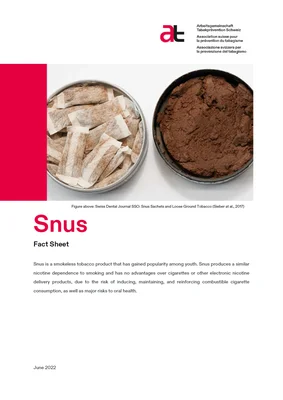Snus and Other Forms of Smokeless Tobacco
Snus is a smokeless tobacco product that has only been allowed in Switzerland since 2019. With the exception of Sweden, it is banned in the European Union. It is very popular among youth, as it can be consumed discreetly anywhere, especially in classrooms. To get around the EU ban, new forms of snus are on the market that do not contain tobacco.
‘‘Snus’’ is the name given to the form of smokeless snuff tobacco traditionally widespread in Sweden. It is a moist, ground oral tobacco product that is typically placed between the upper lip and the gum, often as lose ground tobacco or contained in sachets appearing like small teabags. The snus is typically held in the mouth (without chewing) for approximately 30 minutes before it is discarded.1 2 Typically, ingredients added include water, sodium chloride, humectants (a substance used to keep the snus moist), sodium bicarbonate, and flavouring. Although different products vary in their pH levels, snus typically has a pH in the range 7.8–8.5 to ensure that nicotine is rapidly absorbed through the mucosal membrane.
Snus is not a healthy alternative:
Snus is not a healthy alternative to smoking and users develop nicotine dependence. Global evidence on smokeless tobacco use suggests strong associations with pharyngeal cancers, ischaemic heart disease, stroke and adverse perinatal outcomes.
Snus among youth:
Snus use still is most common in younger generations. Since tobacco use is one of the key determinants of ill-health, changing patterns of tobacco use, including the use of snus, could be influential to the health status of these generations when they grow older. Snus use could be a pathway from smoking to a slightly less toxic form of tobacco use, a way to maintain rather than leave tobacco dependency, or, when going from no tobacco use to snus use, a pathway into a less healthy lifestyle.
Snus as a gateway to smoking:
Some researchers are promoting the use of smokeless tobacco as safer than cigarette smoking and as a possible method for quitting smoking, but smokeless tobacco might be a gateway drug that leads to smoking, and the availability and marketing of smokeless tobacco may keep smokers from quitting.
Sources
Foulds J, Ramstrom L, Burke M, Fagerström K. Effect of smokeless tobacco (snus) on smoking and public health in Sweden. Tob Control 2003;12: 349–59.
Henninger S, Fischer R, Cornuz J, Studer J, Gmel G. Physical Activity and Snus: Is There a Link? International journal of environmental research and public health 2015;12: 7185–98.
Brunnemann, Qi, Hoffmann. Aging of oral moist snuff and the yields of tobacco-specific N-nitrosamines (TSNA), 2001.
https://hams.cc/tobacco1/aging.pdf.
Gmel G, Clair C, Rougemont-Bücking A, Grazioli VS, Daeppen J-B, Mohler-Kuo M, et al. Snus and Snuff Use in Switzerland Among Young Men: Are There Beneficial Effects on Smoking? Nicotine & tobacco research : official journal of the Society for Research on Nicotine and Tobacco 2018;20: 1301–9.
Norberg M, Malmberg G, Ng N, Broström G. Who is using snus? - Time trends, socioeconomic and geographic characteristics of snus users in the ageing Swedish population. BMC Public Health 2011;11: 929.
Tomar SL. Is use of smokeless tobacco a risk factor for cigarette smoking? The U.S. experience. Nicotine Tob Res 2003;5: 561–9.
Siddiqui F, Siddiqi K, Croucher R. Action on Smoking and Health. Evidence into Practice: Smokeless Tobacco, 2020.
AT Switzerland, June 2022
Downloads

